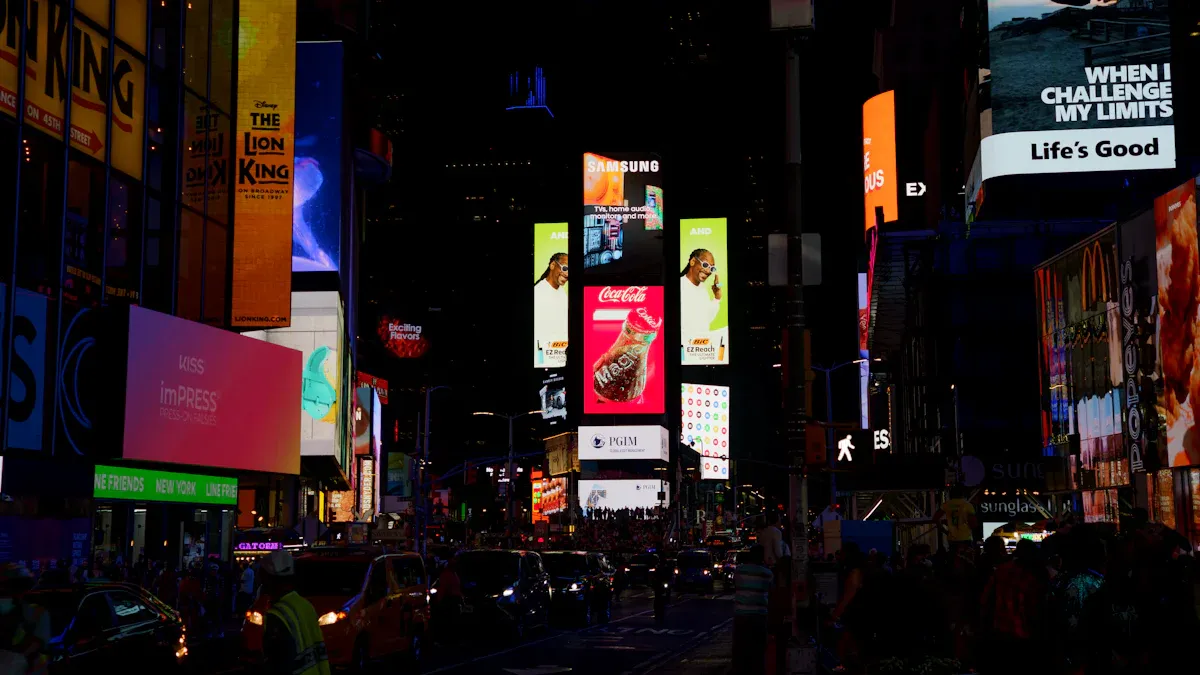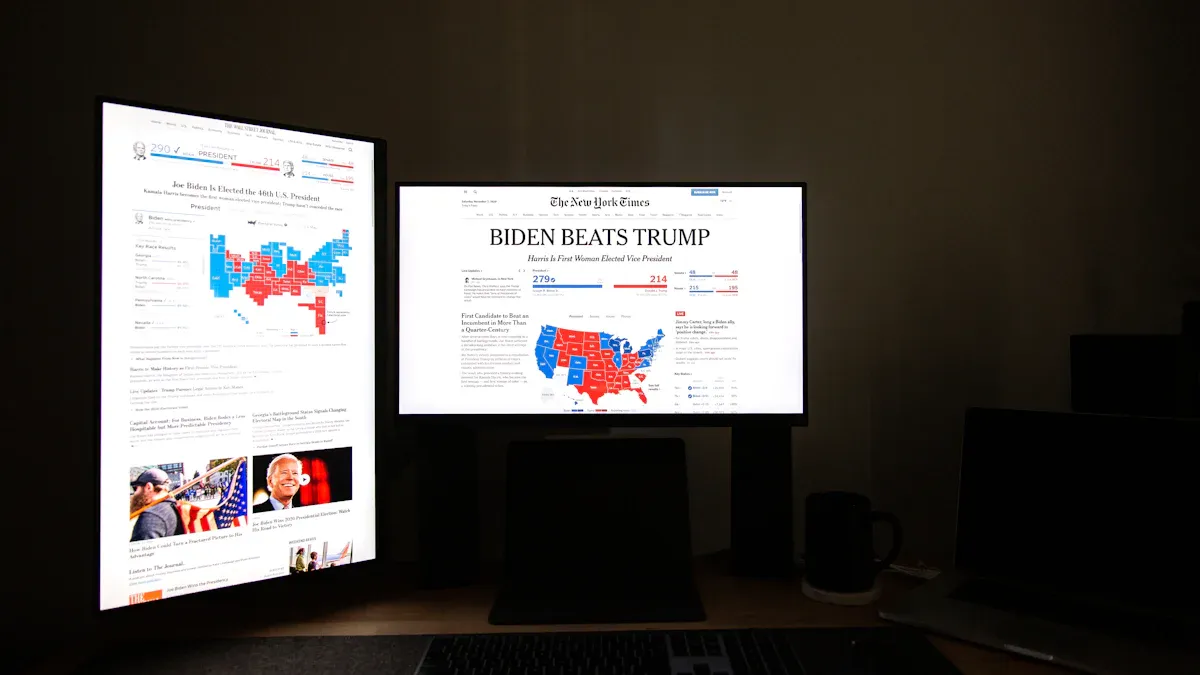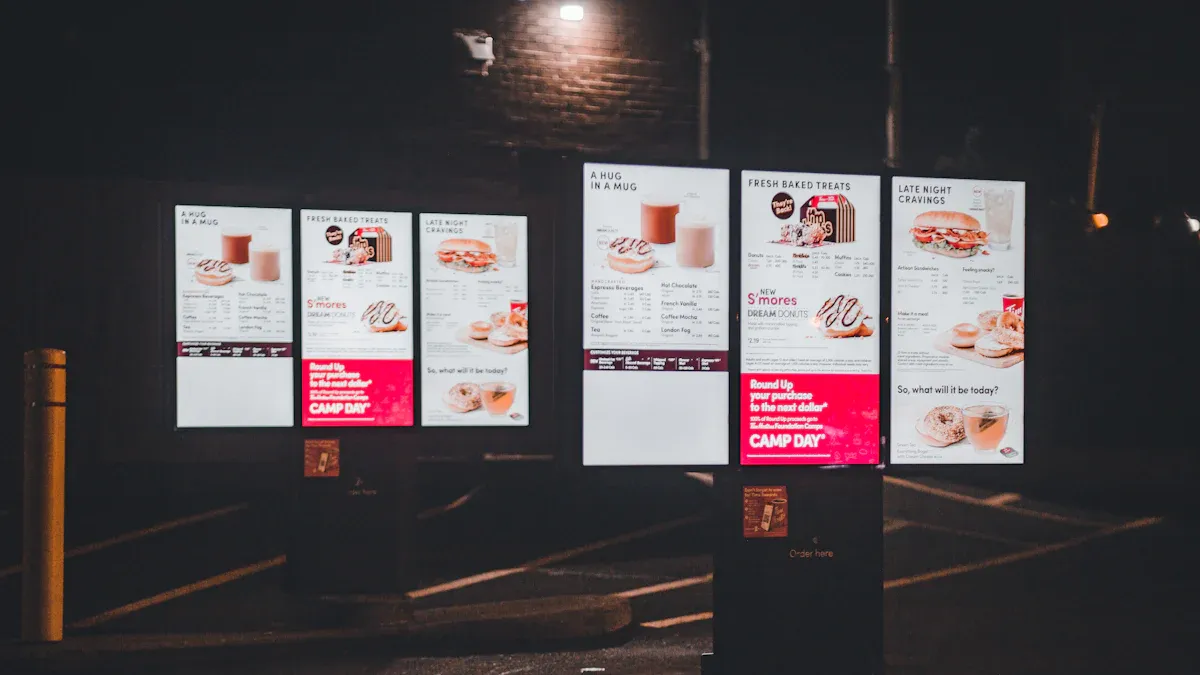Maximizing Impact with Digital Signage Dual Display Systems: Configuration Options, Use Cases, and Performance Benefits

You can transform your customer experience with digital signage dual display systems. These displays create immersive visuals that boost content recall and drive engagement. Digital signage captures attention 400% more than static advertising, and nearly doubles retention rates, as shown below:
Metric Description | Statistic Value | Impact on Audience Retention and Engagement |
|---|---|---|
Recall rate of digital signage | 83% | Nearly double retention compared to traditional advertising |
Views captured by digital displays vs static | 400% more | Significantly higher attention and engagement |
Customer engagement increase | 64% | Majority report higher interaction with digital signage content |
Customer satisfaction increase | 46% | Enhanced positive customer experience |
Time spent browsing products | 30% more | Longer engagement time in stores with digital signage |
Growth in repeat buyers | 32.8% | Indicates improved retention and loyalty |
Upswing in overall sales volumes | 31.8% | Reflects increased customer engagement leading to sales |
Interest in learning more about products/topics | 59% | Shows active audience engagement |
Message recall among viewers | 47% | Demonstrates effective retention of digital signage content |
Hospital patient interaction with digital content | 83% | High engagement in healthcare settings |
Reduction in perceived wait times | 35% | Improves customer experience and retention |

You can use digital signage to display dynamic content, promote advertising, and share real-time information. Dual displays let you show targeted content for different customer groups at the same time. Many businesses report a 31.8% increase in sales and a 46% boost in customer satisfaction by using digital signage for advertising and content delivery. With digital signage, you can improve communication, increase engagement, and create a memorable experience that drives sales and customer loyalty.
Key Takeaways
Dual display digital signage boosts customer engagement by up to 400% and nearly doubles content recall compared to static ads.
Choose the right display setup and mode to fit your space and audience, such as side-by-side, stacked, mirrored, or independent content displays.
Use content management systems to update and control your displays easily, keeping content fresh and relevant to your customers.
Digital signage works well in many places like retail stores, offices, schools, and hospitals to improve communication and increase sales.
Regular maintenance and smart placement of displays ensure long-lasting performance and maximum impact for your digital signage investment.
Configuration Options

Digital Signage Setup
You can choose from several digital signage setup types to match your goals. Each setup changes how you present content and interact with your audience. Here are the main options:
Side-by-Side Displays: Place two displays next to each other. You can show related or different content on each screen. This setup works well for wide spaces like store entrances or lobbies.
Stacked Displays: Arrange one display above the other. You can use this for menus, schedules, or promotions in places with limited horizontal space.
Mirrored Displays: Show the same content on both displays. This setup helps when you want to reach people from different directions, such as in hallways or open areas.
Extended Displays: Stretch one piece of content across both screens. You can create a large, eye-catching visual that grabs attention.
Independent Content Displays: Show different content on each display. You can target different groups or share multiple messages at once.
Tip: Think about your space and audience before choosing a digital signage setup. The right setup improves visibility and makes your content more effective.
Display Modes
You can use different display modes to control how your digital signage works. Each mode offers unique ways to share content and engage viewers.
Synchronized Mode: Both displays show the same content at the same time. You can use this for important announcements or branding.
Asynchronous Mode: Each display shows different content. You can target specific messages to different groups.
Interactive Mode: Add touch or motion sensors. You can let viewers interact with dynamic content, such as directories or product finders.
Rotating Content Mode: Change content on a schedule. You can keep your digital signage fresh and interesting.
A table can help you compare these display modes:
Display Mode | Description | Best Use Case |
|---|---|---|
Synchronized | Same content on both displays | Branding, announcements |
Asynchronous | Different content on each display | Targeted messaging |
Interactive | Touch or motion-based dynamic content | Directories, product finders |
Rotating Content | Scheduled content changes | Promotions, event schedules |
Hardware and Software
You need the right hardware and software for a successful digital signage setup. The right tools help you manage content, keep displays running, and avoid technical problems.
Hardware Options:
Commercial Displays: Use screens designed for long hours and high brightness. These displays last longer than consumer TVs.
LED Panels and Plasma Screens: Choose these for bright, clear images. LED panels work well in bright areas. Plasma screens offer deep colors.
Controllers and Media Players: These devices send content to your displays. You can use one controller for both screens or separate ones for each.
Mounts and Stands: Secure your displays for safety and optimal placement.
Software Needs:
Content Management System: Use this software to upload, schedule, and update content. A good content management system lets you control both displays from one place.
Synchronization Tools: These tools keep your displays in sync. You can avoid glitches and make sure content looks smooth.
Remote Monitoring: Check your digital signage from anywhere. You can fix problems fast and keep your displays running.
Note: Place your displays at eye level for optimal placement. Make sure you test your digital signage setup before going live. This helps you spot and fix any issues early.
You can boost engagement by using dynamic content and keeping your displays updated. Regular checks and updates help you avoid downtime and keep your signage effective.
Use Cases

Retail and Corporate
You can see digital signage dual display systems making a big difference in retail and corporate spaces. Many top brands use these systems to boost advertising, drive sales, and improve customer engagement. For example, McDonald's uses large touchscreen kiosks at entrances and dining areas. These displays let customers browse menus, customize orders, and pay quickly. Adidas places digital screens in pop-up stores, showing real-time promotions and social media feeds. Sephora uses in-store digital signage for product information, personalized experiences, and AR try-on mirrors. These setups increase foot traffic, boost sales, and create seamless shopping experiences.
Company | Environment | Digital Signage Highlights | Impact on Promotions and Customer Engagement |
|---|---|---|---|
McDonald's | Retail | Touchscreen kiosks, interactive menus, payment | Improved order accuracy, faster service, increased upselling, enhanced experience |
Adidas | Retail | Pop-up store screens, interactive mirrors, real-time promotions | Increased foot traffic, social media buzz, real-time marketing |
Sephora | Retail | Product info screens, AR try-on, personalized recommendations | Increased cross-channel sales, seamless shopping experience |
In corporate offices, digital signage delivers important messages, promotes best practices, and celebrates achievements. You can reach employees throughout the day, even those who do not check email often. Combining digital signage with other channels helps you share audience-specific content and improve internal communications.
Education and Transportation
Digital signage dual displays help schools and transit centers share real-time content updates and targeted advertising. In education, you can use signage to show class schedules, event reminders, and emergency alerts. Hospitals use digital signage to improve information flow and patient engagement. At Maribor railway station in Slovenia, dual-sided digital signage provides real-time transit updates and wayfinding. This system improves passenger experience and operational efficiency. You can update content instantly, making time-sensitive advertising and announcements easy.
Hospitality and Queue Management
Hotels, restaurants, and service centers use digital signage to enhance customer experience and manage queues. You can display promotions, menus, and personalized experiences on dual displays. Queue management systems use digital signage to show wait times and direct customers. Studies show that customers find these technologies easy and quick, which increases engagement and satisfaction. In hospitality, digital signage supports targeted advertising and real-time content updates, helping you boost sales and improve customer experience.
Tip: Integrate geo-fencing and mobile devices with your digital signage to deliver personalized, location-based advertising and real-time content updates.
Performance Benefits
Maximum Impact
You want your digital signage to deliver maximum impact. Dual display systems help you reach this goal by making your messages stand out. When you use digital signage, you can increase customer engagement by up to 400% compared to static displays. This means more people notice your advertising and remember your content. In retail, digital signage often leads to a 29.5% increase in average purchase amount and a 31.8% rise in sales volume. These numbers show how much impact digital signage can have on your business.
You can place your signage at key decision points. This strategy can triple your conversion rates compared to displays in less important areas. Frequent content updates also matter. If you refresh your content every week, you can see 28% higher viewer retention than with monthly updates. These benefits show that digital signage dual display systems give you maximum impact and help you reach your business goals.
Tip: Place your digital signage where customers make decisions. Update your content often to keep your audience interested and boost engagement.
Engagement and Flexibility
You can use digital signage to create a flexible and engaging experience for your customers. Dual display systems let you show different content on each screen or synchronize them for a bigger effect. You can update your content in real time, schedule messages for certain times of day, and test which advertising works best. Content management systems make these tasks easy. You can control all your signage from one place and push updates to many locations in minutes.
Here are some ways digital signage boosts engagement and flexibility:
Show targeted advertising to different customer groups at the same time.
Use interactive features like touch screens, motion tracking, and voice recognition to involve your audience.
Collect data on how customers interact with your signage. You can track dwell time, view-through rates, and which content gets the most attention.
Use AI to analyze store traffic, weather, and product performance. This helps you show the right content at the right time.
Schedule content based on customer flow or special events.
Feature | Benefit for Engagement and Flexibility |
|---|---|
Real-time content updates | Respond quickly to trends and customer needs |
A/B testing | Find out which advertising works best |
Interactive signage | Increase customer participation and satisfaction |
Centralized control | Manage all displays easily and efficiently |
You can see how digital signage makes your advertising more flexible and your customer experience more engaging. These features help you stay ahead in a fast-changing market.
Cost Efficiency
You want your digital signage to be cost-effective and efficient. Dual display systems help you save money and improve operational efficiency. You can update your content instantly, which reduces printing costs and waste. Content management systems let you manage all your signage from one dashboard, saving time and labor. Smart energy management and energy-efficient hardware lower your power bills without losing performance.
Digital signage also helps you use your staff more efficiently. Interactive displays can answer customer questions, show directions, or help with orders. This reduces the workload for your team and improves the customer experience. You can measure the cost-effectiveness of digital signage by looking at sales growth, higher engagement, and lower operating costs.
Note: Digital signage supports sustainability. You use less paper and energy, and you can recycle old content with a few clicks.
Here are some ways digital signage improves operational efficiency and cost-effectiveness:
Update content across all locations in minutes, not days.
Reduce the need for printed materials and manual updates.
Use analytics to see which content drives sales and adjust quickly.
Lower energy use with smart displays and scheduling.
Efficiency Feature | How It Saves Money and Time |
|---|---|
Instant content updates | No printing or shipping costs |
Centralized management | Fewer staff hours needed |
Energy-efficient hardware | Lower electricity bills |
Data-driven adjustments | Focus on what works, avoid wasted effort |
You can see that the cost-effectiveness of digital signage comes from both direct savings and better performance. Dual display systems give you more ways to reach your customers, improve your advertising, and run your business more efficiently.
Best Practices
Deployment
You want your digital signage deployment to succeed from the start. Place your displays at decision points and natural gathering areas. This helps your signage reach the most people. Protect your screens from sunlight, dust, and moisture to keep your hardware working longer. Choose commercial-grade displays with the right brightness for your space. Design your content for the highest resolution and use clear, sans-serif fonts. Make sure your content is easy to read from the expected viewing distance. Use RGB color mode and strong contrast to make your message stand out. Keep your content simple so viewers can understand it quickly.
Tip: Test your signage in real conditions before going live. This helps you spot issues with content layout, brightness, or placement.
Content Management
You need a clear plan to manage your signage content. Start by setting goals for your content, like increasing brand awareness or customer engagement. Use the SMART framework to make your goals specific and measurable. Learn about your audience and location to tailor your content. Build a content calendar that matches promotions and seasonal trends. Assign ownership for each content type and set refresh cycles. Rotate your content weekly to keep your signage fresh and interesting. Use analytics to measure how your content performs and adjust based on feedback. Align your signage content with your overall marketing strategy for a consistent message.
A simple checklist for content management:
Define clear content goals.
Know your audience and location.
Plan a dynamic content calendar.
Assign content owners and set refresh times.
Rotate and update content weekly.
Use analytics for content optimization.
Align signage content with marketing.
Maintenance
You want your signage to run smoothly every day. Protect your hardware from heat, sunlight, and moisture with weatherproof enclosures and proper ventilation. Use surge protectors and stable power supplies to prevent electrical damage. Choose hardware built for 24/7 operation. Clean your screens and check cables daily. Test your network and update software monthly. Adjust brightness and rotate content to avoid screen burn-in. Review your maintenance logs every quarter. Secure your network and control who can access your signage system. Use a maintenance checklist before hiring service providers to make sure your signage stays reliable.
Note: Centralized, cloud-based management lets you update content, run diagnostics, and troubleshoot your signage from anywhere. This keeps your signage network running with less downtime.
You can achieve measurable results with dual display digital signage systems by choosing the right setup and focusing on your goals. Many businesses, like McDonald's and Hyatt Regency, saw higher sales and better customer engagement after using digital signage. You can track content performance and link signage to sales for clear ROI.
Review your needs and set clear objectives.
Use analytics to refine your content and signage strategy.
Digital signage continues to grow worldwide, helping you improve communication, boost customer satisfaction, and increase efficiency.
FAQ
What is a dual display digital signage system?
A dual display digital signage system uses two screens to show content. You can display the same message or different messages on each screen. This setup helps you reach more people and share more information at once.
How do you update content on both displays?
You use a content management system (CMS) to update both screens. The CMS lets you upload, schedule, and change content from one place. You can make updates quickly and keep your displays fresh.
Can you use interactive features with dual displays?
Yes, you can add touch screens, motion sensors, or QR codes. These features let people interact with your content. You can guide customers, answer questions, or collect feedback easily.
What are the main benefits of dual display systems?
Dual display systems increase engagement, save time, and reduce printing costs. You can show targeted messages, update content fast, and improve customer experience. Many businesses see higher sales and better communication with this setup.
See Also
Exploring Digital Signage Technology And Effective Implementation Benefits
Steps To Optimize Digital Signage Monitors For Best Results
Maximizing Return On Investment Through Digital Signage Deployment
Choosing Digital Signage Monitors Based On Technology And Use
Understanding LED Digital Signage Displays And Their Key Advantages

